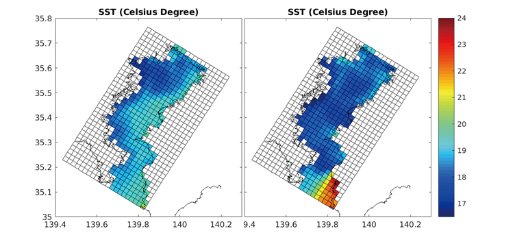Major Research 4A Research on Enhancement and Utilization of Coastal Ecology
Background and Objectives
Rich ecosystems in coastal zones include tidal flats, seagrass meadows, and coral reefs. Coastal zones are valuable places for the global environment. However, during the era of rapid economic growth, intense socio-economic activities caused the deterioration of water quality in coastal inner bays and enclosed waters, resulting in ecosystem damage. Thanks to subsequent countermeasures, water quality has gradually been improving in some coastal zones; however, recovery of the coastal zone environment including ecosystems remains a formidable challenge.
On the other hand, new challenges include the utilization of coastal zone functions for mitigating climate change, as well as countermeasures against large-scale oil spill incidents from maritime industrial complexes and other facilities.
Therefore, in the themes of this research, we will conduct research and development with the following goals: further restoration of the coastal zone environment, coastal zone utilization for climate change mitigation, and establishment of technologies to counter large-scale oil spill incidents.
Research Topics
Research and development comprises the following three subthemes:
1.Research on coastal-ecosystem utilization
Regarding ecosystem-based countermeasures against the impacts of climate change, we will conduct research on alleviating climate change including carbon separation and storage and atmospheric CO₂ uptake, both of which utilize ecosystems (blue carbon) under various conditions including remote islands such as Minamitorishima Island. In addition, we will expand our technological development internationally. We will also develop a technology to create coastal ecosystems which suffer less damage due to earthquakes and tsunamis and which recover rapidly. Through such technologies, we can continuously reap the benefits of the ecosystem.
2.Research on the water-environment simulation and analysis in inner-bay
We will develop the following methods regarding the acquisition and utilization of environment observation data: a new method of analyzing marine monitoring data covering currently operating ferries and monitoring posts and others; and a new method of observing parameters for which common methods cannot obtain adequate results. We will also re-analyze existing underutilized environmental data, and will use multi-functionalized GPS wave-observation buoys to continuously observe areas for which environmental data has not been obtained. In addition, we will integrate weather/marine/ecosystem models and utilize in real time the environmental observation data. Through these means, we will develop a system which comprehensively predicts problems that frequently occur in inner bays, including red tides, blue tides, and hypoxia.
3.Research on countermeasure technologies against sea oil spill
Regarding technologies for dealing with spilled oil, in addition to developing technologies to resolve conventional on-site challenges, we will conduct new research and development on the following: oil-gathering equipment loaded on next-generation oil-recovery ships; and systems which comprehensively recover or treat oil and which can address large-scale oil spill incidents. In addition, we will establish an information system for the risk management of oil pollution based on simulation technology, understand the behavior and mechanisms of oil spilled from dangerous facilities in waterfront areas due to natural disasters including earthquakes and tsunamis, and conduct research and development of quantitative prediction techniques and mitigation techniques for spilled oil. Through such approaches, we will develop innovative countermeasure techniques against oil pollution and improve the ability to respond oil pollution.
Activities in FY 2017
In a global estimates of the efficacy of blue carbon as a means of mitigation and adaptation to climate change, we almost completed the establishment of a new coastal ecosystem model which achieves both blue-carbon quantification in various coastal areas and predictor models of ocean-wave attenuation which take the ecosystem into account. Also, we organized a nationwide estimated value of CO₂ amount absorbed by blue-carbon ecosystems in both 2013 and 2030, and then made the data public.
In a development of integrated prediction and assessment method of coastal benthic ecology and geoenvironmental dynamics, we established and proposed a new method to evaluate the ground environment dynamics of tidelands and beaches. Moreover, we succeeded in comprehensively evaluating the effects of typhoon events on benthic ecosystems and ground environment dynamics. Also, we obtained positive results regarding unified evaluation of the mechanical characteristics of coral-gravel composite soil.
In a cross-sectional observation and analysis of atmospheric and oceanographic issues at bay mouths, regarding atmospheric observation, we investigated affordable measurement methods, used their prototypes, and obtained measurement results. Also, regarding marine observation, we set a unified policy regarding the existing systems and a new marine-observation system on Kanaya-maru.
In a development of evaluating procedure for biodiversity referring to spatial scale in coastal areas, we compared characteristic properties among the habitat environments of several organisms, and then elucidated that Ebi tideland, an artificial tideland, is a highly unique (complementary) environment.
In an analytical study of macro-organisms dynamics on a coastal ecosystem simulation, we added new compartments referring fishes into the existing model and re-structured it to a new one.
In a study on the mechanisms of coastal current and water environment using data assimilation, we could replicate water temperature on the east side of areas around bay mouth in Tokyo Bay, which had not been replicated using a numerical calculation model alone.
In a novel oil spill response technology to cope with various sources including natural disaster triggered oil spills, we investigated the following regarding a technique to prevent the drifting of spilled oil by using bubble curtains: application to port facilities; application to tsunami fires; and application to oil-collection ships. Also, in the development of oil-leakage real-time hazard maps, we developed an oil drifting simulation by using network-type hazard maps and a γ-version all-time system for providing hazard information (trial-operation version).

Comparison of numerical calculation results with data assimilation results in Tokyo Bay regarding sea-surface temperatures
(Left: numerical calculation model; right: data assimilation model)



